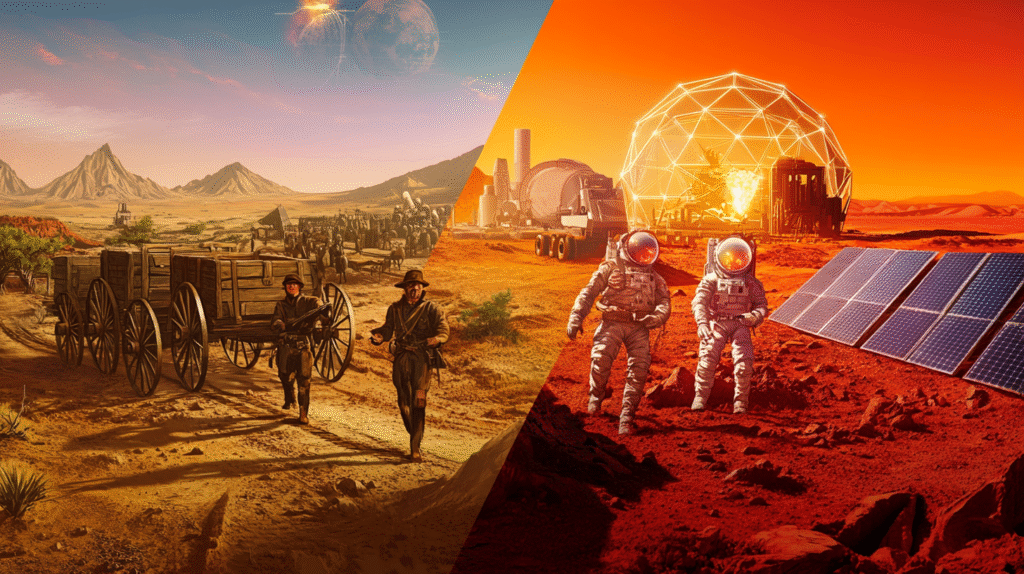The discovery of boron on Mars by NASA’s Curiosity rover has sparked renewed excitement among scientists, engineers, and visionaries alike. This element, known for its unique properties and diverse applications, played a pivotal role in the expansion of the American West in the 19th century and now stands poised to help humanity establish a sustainable presence on the Red Planet. From the dusty landscapes of the historic Southwest to the barren plains of Mars, boron has served as both a catalyst for growth and a symbol of human resilience in the face of harsh environments. This article explores the profound connection between the historical impact of boron mining in the American West and the potential role of boron in the future expansion of human civilization on Mars.
The Discovery of Boron: Earth and Mars
Boron in the American West: Fueling Expansion and Industry
The story of boron mining in the American West began in the late 19th century with the discovery of borate deposits in California’s Death Valley and Mojave Desert. Boron was found primarily in the form of borax, a mineral that quickly became indispensable in various industries, including glassmaking, ceramics, detergents, and metallurgy. The mining of boron-rich deposits played a critical role in the development of the western United States, driving economic growth and attracting settlers to the harsh, unforgiving desert landscapes.
One of the most iconic symbols of this era was the “Twenty Mule Team” used to transport borax from the remote mines of Death Valley to railheads in Mojave, California. The Pacific Coast Borax Company, led by “Borax King” Francis Marion Smith, dominated the industry and transformed boron from an obscure mineral into a household name. The economic impact of boron mining extended beyond the mines themselves; it spurred the development of infrastructure, such as roads and railroads, and helped establish boomtowns in previously uninhabitable regions.
Boron on Mars: A New Frontier for Humanity
Fast forward to the 21st century, and the discovery of boron on Mars has opened a new chapter in the element’s story. NASA’s Curiosity rover detected boron in ancient sedimentary rocks within Gale Crater, an area that once hosted liquid water. The presence of boron on Mars is not just a chemical curiosity; it offers critical insights into the planet’s past habitability and points toward the potential for sustaining human life in the future.
Boron’s detection in Martian rock veins suggests that ancient groundwater on Mars was alkaline and could have supported the chemical reactions necessary for life. This discovery is pivotal because boron stabilizes ribose, a key component of RNA, hinting that the building blocks of life could have formed on Mars under the right conditions. Beyond the implications for ancient life, boron’s presence on Mars signals a wealth of potential resources that could be harnessed for human exploration and colonization, much like its discovery in the American West once fueled the growth of new communities and industries.
The Parallels: Expansion Fueled by Boron
Economic and Industrial Growth: Earth’s Desert and the Martian Desert
In the American West, boron mining catalyzed economic growth in a region that was otherwise seen as inhospitable. The extraction and processing of boron brought jobs, commerce, and technological innovation to areas that lacked other economic drivers. Towns like Boron, California, sprang up around these mines, turning barren desert landscapes into bustling hubs of human activity.
On Mars, boron’s potential to support human civilization lies in its versatility and the essential role it could play in future Martian industries. Boron’s applications in energy storage, such as advanced batteries and fuel cells, could provide reliable power for habitats, rovers, and other critical systems. Its role in agriculture, as a micronutrient essential for plant growth, could help Martian greenhouses flourish, ensuring a steady food supply for settlers.
Much like the mining towns of the American West, human outposts on Mars could eventually grow into self-sustaining colonies, driven in part by the resources that boron can provide. The parallels between these two frontiers highlight how a single element can become the backbone of economic and societal expansion in hostile environments.
Infrastructure Development: Railroads and Radiation Shielding
The expansion of boron mining in the American West necessitated the development of infrastructure that connected remote desert mines to broader markets. Railroads were laid across the Mojave Desert, facilitating the transport of borax and other minerals. This infrastructure was not just about moving goods; it was about connecting communities, spurring further settlement, and integrating the West into the national economy.
On Mars, infrastructure development will also be key to the success of human colonies. Boron’s unique properties make it an ideal component for radiation shielding, protecting habitats, vehicles, and spacesuits from harmful cosmic rays and solar radiation. By integrating boron into building materials and coatings, future Martian settlements can create safer environments for humans, much like how railroads once opened up the West by making it more accessible and livable.
A Symbol of Human Resilience: Overcoming the Harshest Environments
Adapting to Extreme Conditions: From Death Valley to Gale Crater
The mining of boron in the harsh deserts of the American Southwest was a testament to human ingenuity and resilience. Early miners faced extreme heat, isolation, and challenging working conditions, yet they persevered, turning a seemingly worthless landscape into a cornerstone of American industry.
Similarly, Mars presents an even more formidable challenge with its freezing temperatures, thin atmosphere, and high radiation levels. The discovery of boron on Mars represents a beacon of hope—a resource that, if properly harnessed, could help future settlers overcome these challenges. Boron’s role in stabilizing key chemicals, strengthening materials, and providing energy solutions embodies the spirit of adaptation and innovation that has always driven human exploration.
Pioneering Spirit: The Legacy of Expansion
The pioneers of the American West and the future pioneers of Mars share a common thread: the willingness to push the boundaries of what is possible. In the 19th century, boron helped settlers turn deserts into productive land, powering industries that shaped the modern American economy. On Mars, boron could once again help humanity push beyond Earth’s boundaries, supporting the creation of new societies on an alien world.
Conclusion: Boron as a Bridge Between Frontiers
Boron’s discovery on Mars is more than a scientific milestone; it is a reminder of how the same elements that fueled Earth’s expansion can help humanity take its next giant leap. The parallels between the role of boron in the American West and its potential on Mars underscore a broader narrative of exploration, resilience, and innovation. As we look to the future, boron stands as a bridge between our past achievements and the limitless possibilities of a new Martian frontier. The lessons learned from the deserts of Earth may very well guide us as we venture into the deserts of Mars, driven by the same pioneering spirit that has always defined human progress.

